First Takes: From the CEO
Curiosity + Courage = Fearless Science
Welcome to the inaugural publication of Fearless Science.
At the Morgridge Institute, we believe in fearless science. This means we follow interesting and important questions, wherever they may lead. Some may call this risky; we say it’s what scientists are supposed to do.
Curiosity drives us. In fact, it is the ultimate engine that drives science.
The important advances come about because somebody wants to know how something works — and is allowed to do so. Keith Yamamoto, past president of the American Association for the Advancement of Science, recently spoke at Morgridge and noted that 95% of drugs approved by the FDA from 2010 to 2015 were discovered through curiosity-driven research.

Brad Schwartz
This requires patience. The median time from first discovery to approval of the treatments cited by Yamamoto was 32 years. But the payoff is tremendous. Since 1975, for example, the mortality rate from heart disease has improved by 60% or 1 million lives saved per year.
Curiosity-driven science is by its nature unpredictable. There is a tendency to try and increase efficiency by asking scientists to identify intermediate goals in their research. But we are trying to discover what isn’t known. How can we get from point A to point B more efficiently if we don’t know what point B is?
This is why our first issue of the magazine explores some of the fascinating curiosity-driven questions being explored at the Morgridge Institute. We profile the work of Phil Newmark, Daniela Drummond-Barbosa and Kenneth Poss and the fundamental questions of regenerative biology they seek to answer.
We also invite guest scientists who exhibit this philosophy in their careers to share their curiosity-driven approach to basic research.
Eric Wright of the University of Pittsburgh studies bacteria to understand why some antibiotics can avoid resistance. Celina Juliano of UC Davis studies hydras to understand how to harness stem cells. And David Mangelsdorf of UT Southwestern studies nuclear receptors to understand how to counter diseases such as alcoholism.
Curiosity-driven research also requires courage. We recognize the challenge when there is so much pressure to measure accomplishments with shorter-term metrics such as grant dollars attained and papers published.
We are charting our own path. People expect us to focus on discovering truths, and we are determined to live up to this. And we have the courage to do this, because we know that’s what society wants.
We hope you enjoy this deeper look into curiosity-driven science at Morgridge.
Brad Schwartz, CEO
Stories
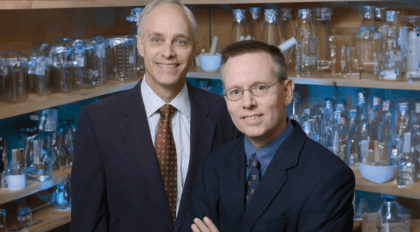
Want to answer a big question in science? Ask a bigger one
Meet David Mangelsdorf, professor and chair of pharmacology at the University of Texas Southwestern Medical Center, who joined the Morgridge Scientific Advisory Board in 2025. Mangelsdorf discusses his lifelong fascination with big, high-risk challenges in science.

Little fish, big splash
Kenneth Poss, Morgridge’s newest investigator, studies how zebrafish can restore what is irreparable in humans — including damaged heart tissue.

Mining millions of genomes for the next powerful antibiotic
High-throughput computing innovations at Morgridge and UW-Madison is enabling a massive research effort to discover new natural compounds that can counter antibiotic resistance.

The infinite worm
Scooped from a fountain in Spain, a colony of planarians help scientists unravel the rules of regeneration.

Rising Sparks: Danielle Lohman, metabolism alum
Morgridge alum lands at the U.S. Department of State, shaping the intersection of science policy and foreign affairs.

‘Listen to what the flies tell us’
The Drummond-Barbosa Lab looks to the tiny fruit fly to understand big complex questions about the relationship between stem cell development and changes in diet, metabolism, and the environment.
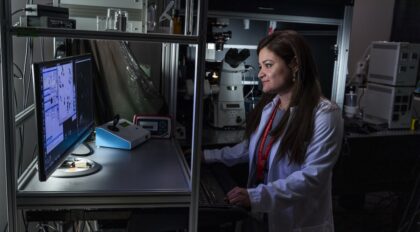
Advanced imaging reveals how a parasitic ‘kiss’ alters cell metabolism
Morgridge researchers harness the power of optical metabolic imaging to study how the parasite Toxoplasma changes host cell metabolism over the course of infection.

Rising Sparks: Andrés Tibabuzo, regenerative biology
From 'Jurassic Park' to snake venom to parasitic flatworms, Andrés Tibabuzo is motivated by the science that fascinates him.
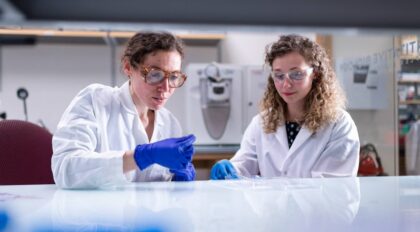
Rising Sparks: Katherine Overmyer, metabolism
Katie Overmyer collaborates with metabolism researchers to push the boundaries of mass spectrometry technology and uncover answers to important biological questions.
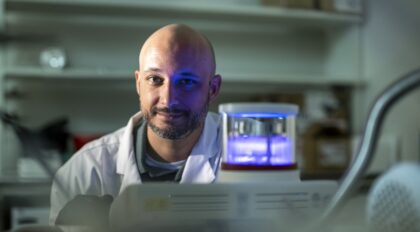
Rising Sparks: Peter Ducos, structural biology
Peter Ducos leans on his military training to solve complex problems and collaborate with other scientists by exploring molecular structures in exquisite detail.
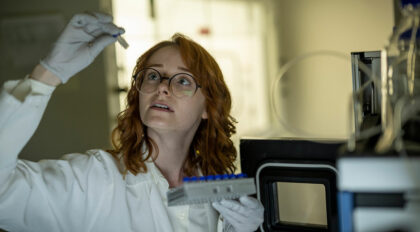
Rising Sparks: Kim Huggler, metabolism
Kim Huggler believes science is fundamentally about creativity, and leverages an innovative cell culture media to reveal biological processes that conventional techniques cannot.
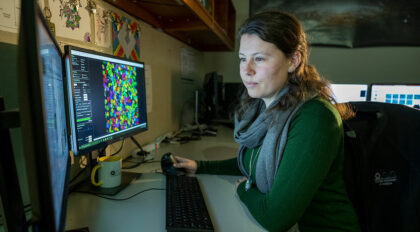
Amani Gillette: An entrepreneur’s journey to improve cancer care
Morgridge Postdoc Amani Gillette discusses her fascinating transition from bench science to entrepreneurship as she steers a new company devoted to improving personalized cancer therapies.

Searching for the biomechanical risk factors of preterm birth
Morgridge scientists have developed new imaging and engineering tools to better understand the mechanical triggers of preterm birth — a health challenge that affects more than one in 10 pregnancies nationally.
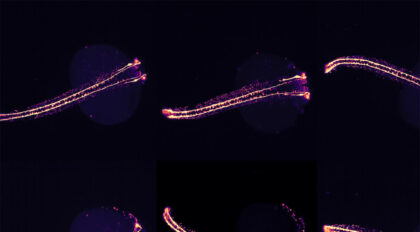
Illuminating Alzheimer’s disease through microscopy
Elizabeth Haynes recently joined the institute as a Morgridge Postdoctoral Research Fellow who is harnessing microscopy to model the early progression of Alzheimer's disease in zebrafish. Haynes's fellowship is a collaboration between the Kevin Eliceiri Lab and Tyler Ulland in the Department of Pathology and Laboratory Medicine at UW–Madison.
Request your own Fearless Science Magazine
Love exploring curiosity-driven research? Request your own print copy of Fearless Science Magazine, our first-ever publication that takes a deep dive into scientific frontiers at Morgridge.
Request a copy today and receive a free “Fearless Science” promotional sticker with the mailing.
"*" indicates required fields
